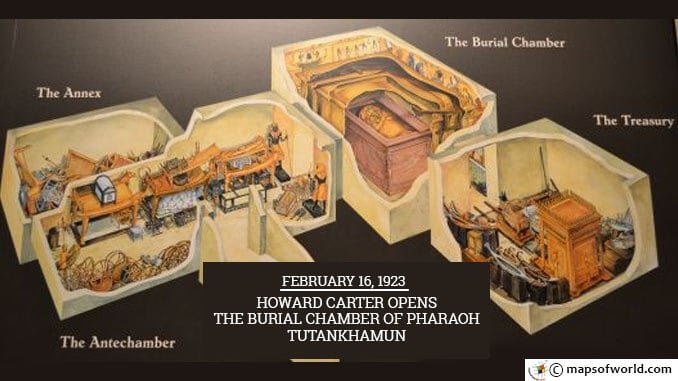The New York Times called February 16, 1923, “perhaps, the most extraordinary day in the whole history of Egyptian excavation” – on this day celebrated Egyptologist and noted archeologist, Howard Carter, unsealed and opened the burial chamber of the 14th century pharaoh King Tutankhamun in the tomb popularly referred to as KV62 in the Valley of Kings near Cairo in Egypt. The tomb came to be known for many of its unique features. Apart from being one of the best preserved tombs in the valley till this day, it also became known for the stupendous hoard of treasures that it contained, despite estimates that an ancient robbery relieved the tomb of about 60% of the wealth that was interred here with the boy king Tut. The history and mysterious civilization of ancient Egypt has been the matter of intense study, research, and debate since the early 20th century. The ancient Egyptian rulers, Pharaohs, considered themselves representatives of the Sun God, Ra. They prepared for their death and burial even as they ascended the throne – building elaborate tombs, designating treasures and significant prizes that were to be buried with them. The designing, building, and consecrating of these tombs took many years – each king trying to outdo his predecessor. The tombs provided archeologists amazing insights into the religion, culture, language, and lifestyle of ancient Egypt and provided tomb raiders access to some of the most precious artifacts, jewelry and treasures known to mankind. King Tutankhamun, the boy king of the 18th Dynasty, reigned between 1332 BC and 1323 BC. There has been much speculation regarding the cause of his death but a chariot accident seems the most likely cause. King Tutankhamun’s tomb had been the subject of investigation for many decades. The British archeologist Edward Russell Ayrton uncovered a pit in the Valley of Kings in 1907. It contained remnants of some pots and dishes and other artifacts that were ascribed to Tutankhamun. Mr. Ayrton and his American sponsor, Theodore M. Davis, then declared that they had found Tutankhamun’s tomb. The artifacts are now New York’s Metropolitan Museum of Art. After a few years of research, Herbert Winlock, the curator of the Met inferred that the pit was not Tutankhamun’s tomb but a pit with the remnants of the king’s funeral and that the original tomb would be found in the vicinity. Taking a cue from Winlock’s research, English archeologist Howard Carter started to look for King Tut’s tomb in the region in 1914. Howard Carter had been working in Egypt for 31 years when he discovered King Tut’s tomb. In 1899, Carter became the Inspector-General of Monuments in Upper Egypt and in 1907, the fifth Earl of Carnarvon, George Herbert, started to fund Carter’s expeditions. For nearly seven years, Carter was unsuccessful in finding the tomb and Lord Carnarvon considered calling off the expedition. Carter convinced him to fund one more year. On November 4, 1922, the archeologist discovered the door to King Tut’s tomb and sent for Lord Carnarvon. After three weeks of excavation work, they unearthed a second sealed door. Carter made a crack wide enough to peep through. In candle light, he noticed the golden gleam of the treasures that were buried in the chamber. Over 2000 pieces of golden statues, jewelry, clothing, perfumes, chariots, and other artifacts were found there. After three painstaking months of cataloging and removing these, Carter finally opened the sealed door to the burial chamber on February 16, 1923. The brilliant chamber was inlaid in gold and blue faience. The next eight months were spent in removing the objects present here including Tutankhamun’s sarcophagus which contained his mummy. Most of these objects are now on display at the Egyptian Museum in Cairo. The walls were adorned with images from Egyptian mythology and hieroglyphics from ancient texts. Egyptian gods – Hathor, Isis, Osiris, and Anubis were shown welcoming the king to the pantheon. The revelation was one of the most striking insights into the history of ancient Egyptian culture. Soon after the opening of the burial chamber of Tutankhamun’s tomb, the press started to write about the Curse of King Tut. On the walls of the tomb, archeologists reported that they had found a text from the ancient Egyptian Book of the Dead. Roughly translated, it reads “Death shall come on speedy wings to those who disturb the peace of the Pharaoh”. It was reported that a King Cobra, a symbol of King Tut, killed Lord Carnarvon’s pet canary on the day the burial chamber was opened. Within a year Lord Carnarvon died due to a mysterious mosquito bite on his left cheek which got infected – the approximate location where King Tut was believed to have been hurt before his death. The Pharaoh’s scarab bracelet bore the words, “Cursed be he who moves my body. To him shall come fire, water and pestilence.” This was gifted by carter to Sir Bruce Ingham, his friend. Ingham’s home was destroyed by a fire soon after. After it was rebuilt, a flood destroyed it again. Howard Carter, though a complete skeptic, reported sighting jackals similar to Anubis (ancient Egyptian the guardian of the dead) in the desert. Objectivity, however, reminds us that only about 8 of the 58 people present during the opening of King Tut’s sarcophagus died within the next twelve years. Carter himself lived to an age of 64 and died of lymphoma in 1939. You may also like : February 16 2005 – The Kyoto Protocol Becomes Binding February 16 1959: Fidel Castro sworn-in as Prime Minister of Cuba
February 16 1923 – Howard Carter opens the burial chamber of Pharaoh Tutankhamun
The New York Times called February 16, 1923, “perhaps, the most extraordinary day in the whole history of Egyptian excavation” – on this day celebrated Egyptologist and noted archeologist, Howard…
